We hear the saying, “you are what you eat” all the time in different contexts. Here are 12 foods that look like the part of the body they most benefit. See how many of these foods you have in your daily diet.
For your overall and future health, eat healthy, whole foods daily to fuel and support our bodies’ healing processes from environmental factors and overall stress. Getting high-quality proteins, fats, carbs, and an array of colors daily keeps us satisfied and away from fake junky foods out there.
A rule of thumb is that the smaller the ingredient list, and the easier the ingredient list is to pronounce, the healthier it is. Whole, healthy foods will have a synergistic blend of nutrition that will positively affect the whole body and the mind and spirit.
Interestingly enough, some foods even look like the organ or body part they support the most. So, I want to run through some examples of foods that explain the saying ‘you are what you eat.’
- Carrots for the eyes. You’ll see when we cut the carrot it resembles an eye. You can even see patterns that look like the pupil and iris. Carrots are filled with vitamins and antioxidants, like beta-carotene, that promote eye health and protect against cataracts and macular degeneration.
- Walnuts for the brain. You see the folds, and even left and right hemispheres. Walnuts are brain food! They contain a very high content of Omega-3s, which are a fabulous anti-inflammatory and promote overall brain function.
- Celery for bones. I tell clients working on bone regeneration to eat at least two spears of celery daily (why not try it with natural walnut butter?). They are a great source of silicon, which is associated with increased bone mineral density.
- Avocados for the uterus. This shape resembles the shape of the uterus, and avocados support reproductive health as well. They are a great source of the B vitamin folate, which reduces the risk of cervical dysplasia and the health of your future offspring. Turn it upside down, and it looks like a head and the brain. Folate is vital for mental health, a balanced mood, and so on. Avocados are also another excellent food for Omega 3s – an anti-inflammatory and super brain food.
- Grapefruits for breast health. This round citrus fruit contains substances called limonoids, which research shows inhibit the development of breast cancer. Grapefruits are also good for the movement of lymph in and out of the breast.
- Tomatoes for the heart. You’ll see that a tomato resembles the structure and chambers of the heart. The high levels of lycopene can reduce the risk of heart disease, high blood pressure, and stroke. Lycopene is high in many red fruits and veggies. You can boost lycopene absorption with a little fat with them. So, Tomato and avocado salads with a bit of extra virgin olive oil or avocado oil can be delicious and beneficial. (Lectins)
- Red wine for the blood. Red wine is rich with antioxidants and polyphenols, including powerful resveratrol. These nutrients can protect the blood against things like LDL cholesterol, for example. There is also a blood-thinning compound in red wine, which reduces blood clotting – associated with strokes and heart disease. This doesn’t mean you should overdo, and you should shop for organic and low sugar red wines.
- Ginger for the stomach. Ginger has an anti-nausea effect and resembles the stomach. The ingredient responsible for ginger’s scent and the taste is called gingerol. It is excellent for nausea, lack of appetite, motion sickness, and stomach pain.
- Sweet potatoes for the pancreas. The shape of a sweet potato has a strong resemblance to the pancreas and also promotes the healthy function of this organ. They are high in the antioxidant beta-carotene, which protects all tissues of the body from damage.
- Grapes for the lungs. Grapes have an undeniable resemblance to the alveoli of the lungs, which are tiny sacs that allow oxygen and carbon dioxide to move between the lungs and the bloodstream. Grapes can reduce the risk of lung cancer and emphysema.
- Bananas for smiles. Bananas contain the amino acid tryptophan, which gets converted into serotonin, the ‘happy and content’ neurotransmitter. Keep smiling.
- Onions and our body cells. The onion family supports detoxification, and the phytochemicals improve vitamin C’s work in the body, which enhances the immune system.
These are just a few small examples of what specific foods are doing to improve your overall health every single day. Try adding one or more of these foods into your daily diet.
Stay Safe and Be Well!





Add Comment